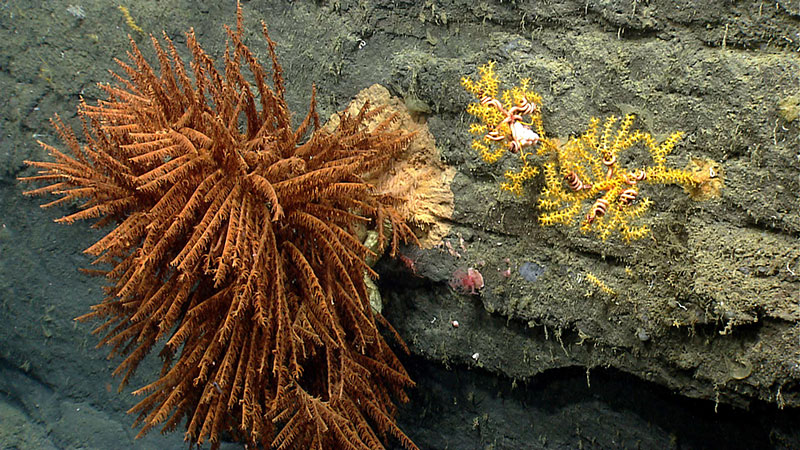
A large black coral and two Paramuricea corals in Oceanographer Canyon. Image courtesy of the NOAA Office of Ocean Exploration and Research, Northeast U.S. Canyons Expedition 2013. Download larger version (jpg, 1.7 MB).

A large black coral and two Paramuricea corals in Oceanographer Canyon. Image courtesy of the NOAA Office of Ocean Exploration and Research, Northeast U.S. Canyons Expedition 2013. Download larger version (jpg, 1.7 MB).
A toadfish covered with parasites sits on the seafloor near Oceanographer Canyon. Video courtesy of the NOAA Office of Ocean Exploration and Research, Northeast U.S. Canyons Expedition 2013. Download video (mp4, 2.8 MB).
Today we had a deep dive along the southeastern wall of Oceanographer Canyon. The remotely operated vehicle (ROV) was on bottom at 1321 UTC at 1,246 meters. The dive track started at the base of a wall and transited up a steep rock slope, with intermittent sedimented ledges, then transitioned to a softer sedimented slope, finishing up at a steep promontory. The dive was characterized by dense colonies of Paramuricea of similar sizes. On the steeper areas, we observed cup corals, Clavularia, Acanella, and other bamboo corals. One large (~ 25 centimeter diameter) cf. Placogorgia was noted, with no obvious ophiuroid associates, despite the presence of several ophiuroids on Paramuricea nearby. During the latter half of the dive, the ROV traversed a sedimented plane with clear ripple marks, signifying consistently high current flow and direction. Beyond the rippled area, on the sediment plain, there were several burrows with a semi-consolidated mud periphery and several white carnivorous sponges, some with eggs. We encountered multiple colonies of cf. Placogorgia and Paramuricea towards the end of the dive, attached to rocks scattered over sedimented slope. Several of these colonies were covered with yellow zoanthids. At least 16 species of corals were observed, with octocorals remaining the most diverse: Swiftia, Acanthogorgia, Paramuricea, Placogorgia, Anthomastus, Acanella, Thourella, cup corals (cf. Javania, Desmophyllum), Parantipathes, Bathypathes, Bathypathes-related, Paragorgia (white and pink), cf. Keratoisis, cf. Eknomisis. Anthothela, unk. bamboo, Solenosmilia, and Clavularia. A few fish species were observed, including black dogfish, Antimora (with isopod parasites), Cottunculus (two, one with isopods), gaidropsarus, synaphobranchids, grenadiers, brotulids, longfin hake, and witch flounder. Several fresh rock fractures were observed, revealing clean surfaces, and rock piles were present at the base of some of the steep slopes. Within the fractured rock, we observed a fossil, possibly an ammonite, at the base of a rock wall. We also observed several coral colonies laying prone on the sedimented rock, possibly knocked over by rock fall. Trash included a ribbon entwined on a dead coral skeleton and monofilament laying on the sediment surface. Dive ended at a steep promontory with large colonies of Paragorgia at 872 meters. The ROV was off bottom at 1959 UTC at 891 meters.